
School Climate and TeachersŌĆÖ Motivational Variables: Effects on Teacher Satisfaction and Classroom Motivational Climate Perceived by Middle School Students. A Cross-cultural Study
[Clima escolar y variables motivacionales del profesorado: efectos sobre la satisfacci├│n de los docentes y el clima motivacional del aula percibido por los estudiantes de secundaria. Un estudio transcultural]
Jesús Alonso-Tapia y Miguel Ruiz-Díaz
Universidad Aut├│noma de Madrid, Spain
https://doi.org/10.5093/psed2022a4
Recibido a 10 de Agosto de 2020, Aceptado a 15 de Octubre de 2021
Resumen
This paper seeks two objectives. First, to study the potential effect of teachers’ perception of school climate and teachers’ motivational variables related to students on teachers’ satisfaction with school, and classroom motivational climate (CMC). Second, to validate a battery of questionnaires for assessing different teachers’ motivational variables related to students: motivational knowledge, teachers’ focus on students’ grades and emotional needs, and expectancies. In total, 441 teachers and 5,380 students from Spain and Costa Rica participated in the study. Confirmatory factor analyses showed the adequacy of each questionnaire structure. Besides, results on correlation and regression analyses showed, first, that school climate perception, together with teachers’ expectancies are the main factors potentially influencing teachers’ satisfaction with school. Second, that CMC does not depend on teachers’ satisfaction, but only on two components of school climate – teacher’s mutual support and students’ attitudes –, and on self-efficacy expectancies. In both regression analyses – satisfaction and CMC –, cross-cultural differences were found.
Abstract
Este trabajo persigue dos objetivos. En primer lugar, estudiar el efecto potencial de la percepción del clima escolar por parte de los profesores y de las variables motivacionales de estos relacionadas con los estudiantes en la satisfacción de los profesores con la escuela y el clima motivacional del aula (CMC). En segundo lugar, validar una batería de cuestionarios para evaluar las diferentes variables motivacionales de los docentes relacionadas con los estudiantes: conocimiento motivacional, enfoque de los docentes en las calificaciones y necesidades emocionales de los estudiantes y expectativas. En total, 441 profesores y 5,380 estudiantes de España y Costa Rica participaron en el estudio. Los análisis factoriales confirmatorios mostraron la adecuación de la estructura de cada cuestionario. Además, los resultados de los análisis de correlación y regresión mostraron, en primer lugar, que la percepción del clima escolar, junto con las expectativas de los profesores, son los principales factores que pueden influir en la satisfacción de los profesores con la escuela. En segundo lugar, que el CMC no depende de la satisfacción de los profesores, sino solo de dos componentes del clima escolar, el apoyo mutuo de los profesores y las actitudes de los estudiantes, y de las expectativas de autoeficacia. En ambos análisis de regresión, satisfacción y CMC, se encontraron diferencias transculturales.
Palabras clave
Clima escolar, Satisfacci├│n de los profesores, Conocimiento motivacional de los profesores, Expectativas de los profesores, Clima motivacional del aulaKeywords
School climate, TeachersŌĆÖ satisfaction, TeachersŌĆÖ motivational knowledge, TeachersŌĆÖ expectancies, Classroom motivational climatePara citar este art├Łculo: Alonso-Tapia, J. y Ruiz-Díaz, M. (2022). School Climate & TeachersŌĆÖ Motivational Variables: Effects on Teacher Satisfaction and Classroom Motivational Climate Perceived by Middle School Students. A Cross-cultural Study. Psicolog├Ła Educativa, 28(2), 151 - 163. https://doi.org/10.5093/psed2022a4
jesus.alonso@uam.es Correspondencia: jesus.alonso@uam.es (J. Alonso Tapia).It is a known fact that the different components of classroom climate have important effects on students’ behavior, engagement, and achievement (Evans et al., 2009). One especially important component is “classroom motivational climate” (CMC) (Ames, 1992), a construct related to classroom goal structures (Alonso-Tapia & Fernández, 2008; Bardach et al., 2019). CMC is created by the teachers’ supporting and teaching actions that affect students’ motivation and learning, though it is usually assessed through the students’ perceptions. The CMC learning/mastery-oriented depends on the degree to which at least sixteen teaching patterns are present in the classroom organization and development (Alonso-Tapia & Fernández, 2008). These patterns are shown in Figure 1. Students themselves recognize that the more the CMC is learning-oriented, the more their interest, effort, perceived ability, self-regulation, success expectancies, and resilience improve (Alonso-Tapia, 2016; Alonso-Tapia et al., 2014; Alonso-Tapia, Ruiz, et al., 2020). Besides, there is abundant evidence on the positive effects of some particular patterns, not only on students’ perception but also on students’ engagement and achievement (Harbour et al., 2015; Lazowski & Hulleman, 2016). However, teachers differ in the degree to which they create a CMC learning-oriented (Alonso-Tapia & Fernández, 2008). This fact poses the problem of knowing the external and personal factors that can be responsible for such differences. Given the importance of CMC for students’ motivation and learning, identifying such factors can help to decide the kind of intervention needed for assisting teachers to improve the CMC they create. Therefore, the main objective of this study is to contribute to identifying such factors. Evidence on external and personal factors responsible for differences in CMC is rather scarce, though there is evidence on factors affecting educational processes conceptualized under similar constructs, such as classroom goal structures (CGS), classroom management skills (CMS), or teaching effectiveness (TE). Considering “external factors”, in a recent meta-analysis covering 59 studies, Kaya and Selvitopu (2019) have pointed that a positive “school climate” and “sharing common values and culture with their colleagues” are associated with the use of better classroom management skills, a concept similar to classroom motivational climate, but that also encompasses classroom discipline climate and classroom emotional climate. Moreover, Benita et al. (2019) have pointed to some important components of school climate – principal and colleagues’ support – as factors associated with teachers’ lack of satisfaction – even depersonalization – and classroom malfunctioning. Barnes et al. (2018) have also considered that school motivational goal orientation, another component of school climate according to Alonso-Tapia, Quijada, et al. (2020), affects the quality of teaching practices. Besides, Lai Eng Fei and Han (2019), in a sample of 2,738 secondary school teachers, also found that teachers’ job satisfaction – a personal factor – mediates the relationship between school climate and teachers’ work performance. According to the information gathered, it seems reasonable to analyze the degree to which school climate quality influences the degree to which CMC is learning-oriented, as well as the possible mediating role played by teachers’ satisfaction with school. As for “personal factors”, the degree to which CMC is learning-oriented may depend on 1) teachers’ motivational knowledge – whether teachers know in a practical way how to create such a climate; 2) their will to apply such knowledge efficiently, paying attention to student effort as well as progress; 3) the degree to which they recognize the importance of managing efficiently the students’ emotional needs, especially those linked to academic experiences; and 4) teachers’ efficacy and control expectancies related to students. However, CMC quality may also depend on behavioral teaching habits used without being conscious of the reason for their efficiency or the lack of it, being habits acquired through practice and experience reinforcing them. If these are the possibilities, what is the evidence backing each one of them? It is not well known whether teachers’ satisfaction with school – not only with life –, motivational knowledge, and attitudes and expectancies related to their students, contribute to differences in CMC and, therefore, to the effects of CMC on students. However, though scarce, there is some evidence related to the role of such personal factors on the configuration of CMC. htiyarolu (2018) found that teachers’ level of “satisfaction with life” – not satisfaction with school – correlated positively with – as named by the authors – “teachers’ appreciative profile” of classroom management (“in an appreciative classroom management profile, the reasons for limitations and controls are explained to students, to support learner-autonomy and individuality”, p. 2228), and negatively with “teachers’ indifferent management profile” (“in this profile, teachers have a lower level of participation in class activities and exhibit a higher level of indifferent behaviors”, p. 2228). Kaya and Selvitopu (2019) also pointed that teachers’ satisfaction with their job, a personal factor, is positively associated with more effective classroom management skills. Besides, it has been found that, though teachers’ satisfaction seems to be affected by school working conditions (Toropova et al., 2020), it may be also affected by school climate (Alonso-Tapia, Quijada, et al., 2020). Hence, we decided to study in more detail the relationship between school climate, teacher satisfaction with school, and classroom motivational climate. Concerning “teachers’ motivational knowledge”, as far as we know, only the study by Haselhuhn et al. (2007) provided some evidence on the role of motivational knowledge assessed from the point of view of the own teachers, a knowledge that may not match the practical knowledge that they use to guide their daily practice to motivate the students, and shown in everyday behaviors. Certainly, there are many studies on a partially related construct – teachers’ pedagogical knowledge – (Chai et al., 2013; McDonald, 2019). However, this knowledge is also assessed through the own teacher’ self-report and, as it can be deduced from item content analysis, and it assesses self-efficacy perception for managing students’ learning processes, not the practical knowledge that can motivate their pupils (Chai et al., 2011). Only Alonso Tapia, Quijada, et al. (2020) provided some evidence on the role of teachers’ practical knowledge and expectancies on students’ motivation, but additional support is necessary. Therefore, it was decided to gather evidence of the relationship between practical motivational knowledge and CMC. Another personal factor to be considered is “teachers’ focus only on performance” or also “on effort when grading students”. It is a fact that Secondary and High School teachers use many different criteria for grading students, such as student ability, achievement, behavior, and effort (McMillan, 2001; Randall & Engelhard, 2010). “Achievement” is the criterion most frequently used. Tests and exams are the methods more frequently used for assessing it, but the remaining criteria are also frequently used. Besides, there is evidence that assessment and grading practices have important effects on learning motivation at the Middle School level (Stebbins, 2019). Therefore, it is important to know whether the degree to which teachers focus only on achievement criteria for grading their students, or on criteria such as behavior or effort, plays a role in the type of CMC perceived by their students. As for “teachers’ interest and competence to deal with students’ socio-emotional needs”, to the extent in which the way teachers treat their students obeys to a more or less regular positive pattern (Carson-Clemons, 2020; Jennings & Greenberg, 2009), it influences the adaptation, motivation, engagement, academic and social learning, and achievement of the students (Murphy, 2016; Patrick & Ryan, 2005). It has been found that, in general, the empathy and positive support of the teacher favor interest, effort, and satisfaction with school work (Joe et al., 2017), as well as satisfaction with the way they are treated by teachers (Butler, 2012; Cornelius-White, 2007). Besides, when students perceive that the teacher is close and willing to help them, they ask for help more frequently (Newman & Schwager, 1993), they behave better in class (Ryan & PatricK, 2001), and they miss fewer classes (Moos & Moos, 1978). And, finally, the greater the support received from the teacher, the better the affective state and psychological well-being, between 8- and 19-years old students (Liu et al., 2016). All these facts suggest that the teacher’s attention to a student’s socio-emotional needs could favor the student’s perception of a classroom climate propitious to learning. Finally, it is a well-known fact that teachers’ “self-efficacy” (TSE) and “control expectancies” (TCE) play an important role in classroom processes, student academic adjustment, and teacher well-being, as shown in the 40 years research synthesis by Zee and Koomen (2016). Expectancies seem to be positively linked to teachers’ behavior and practices related to classroom quality, and teachers’ psychological well-being. This fact implies that even if teachers’ motivational knowledge is adequate, even if they focus on performance and effort when grading their students, and even if they are fond of students and interested in their emotional needs, they may not act following such a knowledge. It may depend on the degree to which they believe that if teachers act in a determined way, this way of acting will allow obtaining a particular effect (TCE) and, especially, on the degree to which they believe that they will be able to act in such a way (TSE) (Alonso-Tapia, Quijada, et al., 2020; Bandura, 1997). Therefore, teachers’ expectancies are another motivational variable to consider for explaining both, teachers’ satisfaction with school and the classroom motivational climate that they create with their teaching patterns. Summarizing, school climate, teachers’ variables related to students, including 1) quality of motivational knowledge, 2) degree of focus on achievement or also on effort when grading, 3) degree of interest on students’ emotional needs, and 4) degree of efficacy and control expectancies related the possibility of promoting students’ progress, may contribute to teachers’ satisfaction and to the type of classroom motivational climate they create. Given the nature of the variables assessed, we expect positive relations between predictors and criteria in all cases except in the case of “focus on achievement or also on effort when grading”. Focusing on achievement might orientate students to performance instead of learning, and if this would the case, the relationship could vary according to evidence found on the interaction between performance orientation and CMC (Alonso-Tapia & Fernández, 2008). The main objective of this study is to test such relations. However, we did not find instruments adequate to our purpose and context for assessing the variables mentioned. Therefore, it was decided to develop first a battery of questionnaires for assessing the teachers’ motivational profile related to students based on previous studies carried out on this same battery by Garazo (2016). Participants A total of 441 secondary and high school teachers along with 5,379 students from 27 schools – 14 from Costa Rica (CR) and 13 from Spain (SP) – participated in this study. The Costa Rica subsample included 178 teachers (53% female, and 47% male), age ranged from 21 to 64 years (mean = 37.6, SD = 9.3), and teaching experience from 1 (8 teachers) to 36 years (1 teacher) (mean = 10.9, SD = 6.3). The Spanish subsample included 263 teachers (67% female, and 33% male), age ranged from 24 to 63 years (mean = 44.8, SD = 9.3), and teaching experience from 1 (9 teachers) to 40 years (1 teacher) (mean = 15.8, SD = 10.1). The teachers participated voluntarily after their schools received information explaining the purpose of the study. The sample of students also included two subsamples from both countries. The CR sub-sample included 1,946 students (49% female, and 51% male). Age ranged from 12 to 20 years (mean = 15.07, SD = 1.77). By educational level, 968 belonged to the first cycle of Secondary School (ages 11-15), 686 to the second cycle (ages 15-17), and 392 were High School or vocational training students (ages 17-20). The SP sub-sample included 3,433 students (54% female and 46% male). Age ranged from 11 to 20 years (mean = 14.96, SD = 1.80). By educational level, 1,277 belonged to the first cycle of Secondary School (ages 11-15), 1,154 to the second cycle (ages 15-17), and 1,002 were High School students (ages 17-20). The fourteen participant schools in Costa Rica were chosen by the educational authorities to be representative of different regions of the country. All of them were public schools. The thirteen Spanish schools were chosen by convenience reason among those that accepted to participate. Seven were public schools and six concerted schools, all of them from Madrid. Procedure Spanish teachers participated voluntarily after their schools received an informative letter explaining the purpose of the study. Since research has shown that paper-and-pencil and Internet data collection methods are generally equivalent (Weigold et al., 2013) the questionnaires were provided in both formats to make them more accessible. Most teachers did it in paper and pencil format, and only the teachers that could not answer in this way did it through the internet. The Research Ethics Committee of the Universidad Autónoma of Madrid approved the present study. Data from Costa Rican teachers were collected as part of a project carried out for the Costa Rica Ministry of Public Education (Alonso-Tapia, 2017). The purpose of this project was to assess teacher perceptions of school climate and to provide advice to improve teaching quality. Teachers completed the questionnaires in paper-and-pencil format. Before applying the questionnaires, the instruments, originally written in Iberian Spanish, were adapted to the cultural peculiarities of Costa Rica by a professor of linguistics of this country. This cultural adaptation was finally discussed with the Spanish researcher carrying out the study. Instruments Teacher’s Motivational Knowledge Abbreviated Questionnaire (TMK-AQ). This questionnaire, developed for this study, is a short version of the TMK developed by Alonso-Tapia, Ruiz, et al., 2020. It has only one scale with 12 five-point Likert-type items, ranging from 1 (strongly disagree) to 5 (strongly agree). These items allow assessing the motivational importance that teachers give to a sample of teaching patterns that contribute to motivating students to learn (Alonso-Tapia & Fernández, 2008). A previous study by Garazo and Alonso-Tapia (2016) provided initial evidence about the adequacy of the structure. An initial version of this questionnaire had been validated by the Alonso-Tapia, Ruiz, et al. (2020). The study by Garazo (2016) tested the adequacy of a short version found to be of similar quality. Battery of Teachers’ Motivational Variables related to Students (B-TMV-S). This battery developed for this study includes three questionnaires answered in five-point Likert-type items, ranging from 1 (strongly disagree) to 5 (strongly agree). The three questionnaires are based on a previous study by Garazo and Alonso-Tapia (2016). This study provided initial evidence about each questionnaire structure adequacy, which will be retained for validation purposes. The questionnaires are the following. Teachers Focus on Students’ Grades (TFSG). This questionnaire has 9 items grouped in three subscales: 1) teachers’ focus on comparing students’ performance, 2) teachers’ focus on students’ performance versus students’ effort, and 3) focus on stressing publicly the importance of grades. The general scale is Teachers’ Focus on Students’ Grades. Teachers focus on students’ emotional needs (TFSEN). This questionnaire has 10 items grouped in three subscales: 1) teachers’ “interest” in students’ emotional needs, 2) teachers’ “attention” on students’ emotional needs, and 3) teachers’ “consciousness” on students’ emotional needs. The general scale is Teachers’ Focus on Students’ Emotional Needs. Teachers’ expectancies on managing students (TEXPS). This questionnaire has 8 items grouped in two subscales: 1) teachers’ self-efficacy expectancies (TSE), and 2) teachers’ control expectancies (TCE). The general scale is Teachers’ Expectancies on Managing Students. School Climate Profile Battery (Alonso-Tapia, Quijada, et al., 2020). The school climate profile battery includes five questionnaires that, if combined, provide a measure of school climate using five-point Likert-type items, ranging from 1 = strongly disagree to 5 = strongly agree. The scores on the individual questionnaires are combined after typifying and transforming them into t-scores. The questionnaires are the following. Leadership Quality Questionnaire (LQ-Q). This questionnaire, with 24 items, allows assessing two general dimensions of leadership, each one including several components. The scale for the first dimension, “communication, and support to teachers”, includes four variables: 1) democratic leadership, 2) clear and constant communication, 3) support to demands of the teaching staff, and 4) support to teachers facing difficulties with families/students. The scale for the second dimension, “management and values of the school”, includes five variables: 1) orientation towards learning versus performance, 2) planned management, 3) interest in obtaining resources for the school, 4) cooperative work among teachers stimulation, and 5) positive coexistence climate fostering. This questionnaire has shown satisfactory psychometric properties (ω = .99 for the global scale). Quality of Teachers’ Support Questionnaire (QTS-Q). With 12 items, this questionnaire includes three scales that allow assessing three dimensions of perceived teachers’ support to their colleagues, each one including two variables: 1) “desire to improve as a teacher”, whose components are “showing a continuous effort in the daily work”, and “proposing new initiatives”, 2) “work support among coworkers”, whose components are “helping other teachers” and “working cooperatively”, 3) “emotional support”, whose components are “comprehension versus criticism” and “help with worries”. This questionnaire has also shown adequate psychometric properties (ω = .96 for the global scale). School Motivational Orientation Questionnaire (SMO-Q). With 12 items, this questionnaire includes two scales that allow assessing, as perceived by teachers, the “school motivational orientation towards learning” and the “school motivational orientation towards performance” (e.g., “In my school those students with higher grades are congratulated publicly to motivate the rest of the students)”. This questionnaire showed good reliability (ω = .99 for the learning orientation scale, and ω = .99 for the performance orientation scale). Quality of Students’ Attitude Questionnaire (QSA-Q). With 14 items, this questionnaire allows assessing four types of students’ attitudes as perceived by teachers: 1) “students’ confidence in teacher”, 2) “cooperation with the teacher and with classmates”, 3) “classroom discipline”, and 4) “students motivation” (interest in the subject, and effort to achieve learning goals). The reliability coefficient was ω = .96 for the global scale. Quality of Parental Support Questionnaire (QPS-Q). With 8 items, this questionnaire allows assessing the families cooperation with the school, that includes for components: “cooperation with the teacher”, “contribution from parents to students trusting the teacher”, “respect towards teacher”·, and “role of parents in the interest and effort of students to learn”. The reliability coefficient was ω = .95. Teachers’ Satisfaction Scale (TSS; Alonso-Tapia, Quijada, et al., 2020). This scale includes 14 items to be answered in a five-point Likert-type format, ranging from 1 = strongly disagree to 5 = strongly agree. This scale allows assessing satisfaction coming from two different sources, first, the “satisfaction with the school and coworkers” and, second, the “satisfaction with the students and their families”. The first source includes five components: 1) “satisfaction with the work of the management team”, 2) “satisfaction with the teaching-learning system”, 3) “satisfaction with the relationships among teachers”, 4) “satisfaction with school rules”, and 5) “satisfaction with the coexistence and security climate of the school”. The second source includes two components: 1) “satisfaction with the learning and recognition shown by the students”, and, 2) “satisfaction with the support received from parents”. The reliability coefficient was ω = .96 for the first subscale, ω = .99 for the second subscale, and ω = .83 for the global scale. Classroom Motivational Climate (CMC-Q; Alonso-Tapia & Fernández, 2008). This questionnaire was designed to cover sixteen kinds of teaching patterns that could affect the students’ motivation to learn. These patterns are novelty; previous knowledge activation; stating explicitly the relation between topics, and the learning objectives; favoring students’ participation; clearly organizing classroom activities; supporting autonomy; showing how to work step by step; illustrating concepts and procedures with many examples; pacing the rhythm; giving frequent feedback; use of assessment to favor learning; frequent use of praise; and treat students with equity and caring each pupil with affection. Two items were written to assess each pattern, forming a parcel. One of them was positive and the other negative to avoid acquiescence effects. Each item had to be answered by the students on a five-point Likert scale, and the score of each pattern, which included two items, ranged from 1 to 10. The reliability indexes are very good (α = .93, ω = .98). Data Analyses Confirmatory factor analyses. To determine the structural validity of all the new questionnaires, the original teachers’ sample was randomly divided into two subsamples. The first was used to check the structural validity of each questionnaire, imposing the structure proposed in the original studies by (Alonso-Tapia, Ruiz, et al., 2020) and Garazo (2016), and estimated by confirmatory factor analysis (CFA). The second sample was used, together with the first one, to test the structure stability by cross-validation, as well as different levels of invariance (unconstrained invariance = configural invariance; metric invariance = invariance of measurement weights; scalar invariance = invariance of intercepts; and so on). Lastly, to test for cross-cultural structural validity, multi-group analyses by country were carried out, for each one of the questionnaires, and different levels of measurement invariance were also tested. The maximum likelihood estimation method was used in all CFA, after calculating the Mardia coefficient (≤ .70; Rodríguez & Ruiz, 2008) to see whether data were adequate for its use. Different types of fit indexes were used: χ2, χ2/df, TLI, CFI, and RMSEA, as well as the criteria for acceptance or rejection of adjustment suggested by Hair et al. (2010): χ2/df < 5; TLI and CFI > .90, RMSEA < .08). In multi-group analysis, IBM SPSS v26 and AMOS v26 were used to compute statistical analyses. Reliability analyses. Scale reliability was assessed using the Cronbach’s α and McDonald’s ω indices. Correlation and regression analyses. To obtain initial information on the convergent and discriminant validity for the new questionnaires, and on their concurrent validity concerning the two criterion variables of interest in this study – teachers’ satisfaction with school and classroom motivational climate – several types of analyses were made. Previously, as the CMC-Q is answered by students, not by teachers, the mean score of the students of his/her classroom was computed, to obtain the CMC score for each teacher. Correlations were calculated between the new questionnaires – TMK and questionnaires included in the TMP battery – and the scores for the rest of the questionnaires used in the study. This is to say: the Teachers’ Satisfaction Questionnaire (TSAT), the Perception School Climate general score (PSCLIM) derived from the five questionnaires included in the battery of School Climate (their corresponding overall scores), and the Classroom Motivational Climate mean score (CMC). Two groups of regression analyses were realized. In the set group, in order the see the relative weight of the variables assessed by the new questionnaires for predicting teachers’ satisfaction, five regression analyses were carried out. In the first analysis, predictors were the scores in the TMK, and the questionnaires included in the TMP battery: teachers’ performance vs. effort orientation, teachers’ orientation to students’ emotional needs, teachers’ self-efficacy expectancies, and teachers’ control expectancies. In the second analysis, the score on teachers’ perception of school climate (PSCLIM) was added to the set of predictors used in the first analysis. In the third analysis, PSCLIM was substituted by its components. Finally, in the fourth and fifth analyses, similar to the third one in predictors and criteria, results from Costa Rican (CR) and Spanish (SP) teachers were compared. In all cases, the criterion was the score on the teachers’ satisfaction scale. Figure 2 Teachers’ Motivational Knowledge (TMK). Hierarchical Model. Standardized Weights and Variance Explained.  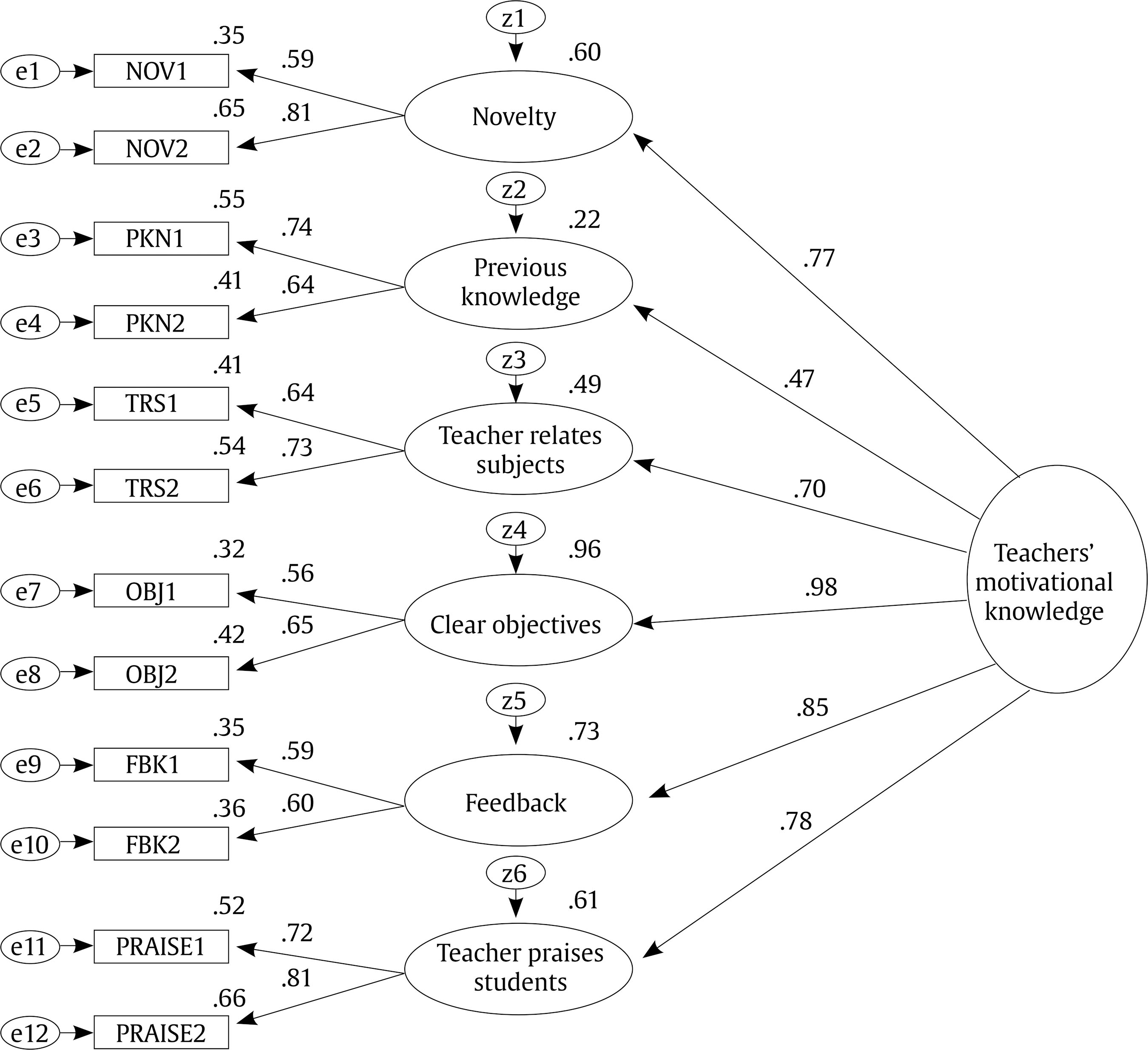 Note. NOV = teacher uses novelty; PKN = teacher activates previous knowledge; TRS = teacher relates subjects; OBJ = teacher explains objectives clearly; FBK = teachers gives frequent feedback; PREISE = teacher praises students. Figure 4 Teachers Focus on Students’ Emotional Needs (TFSEN). Standardized Weights and Variance Explained.  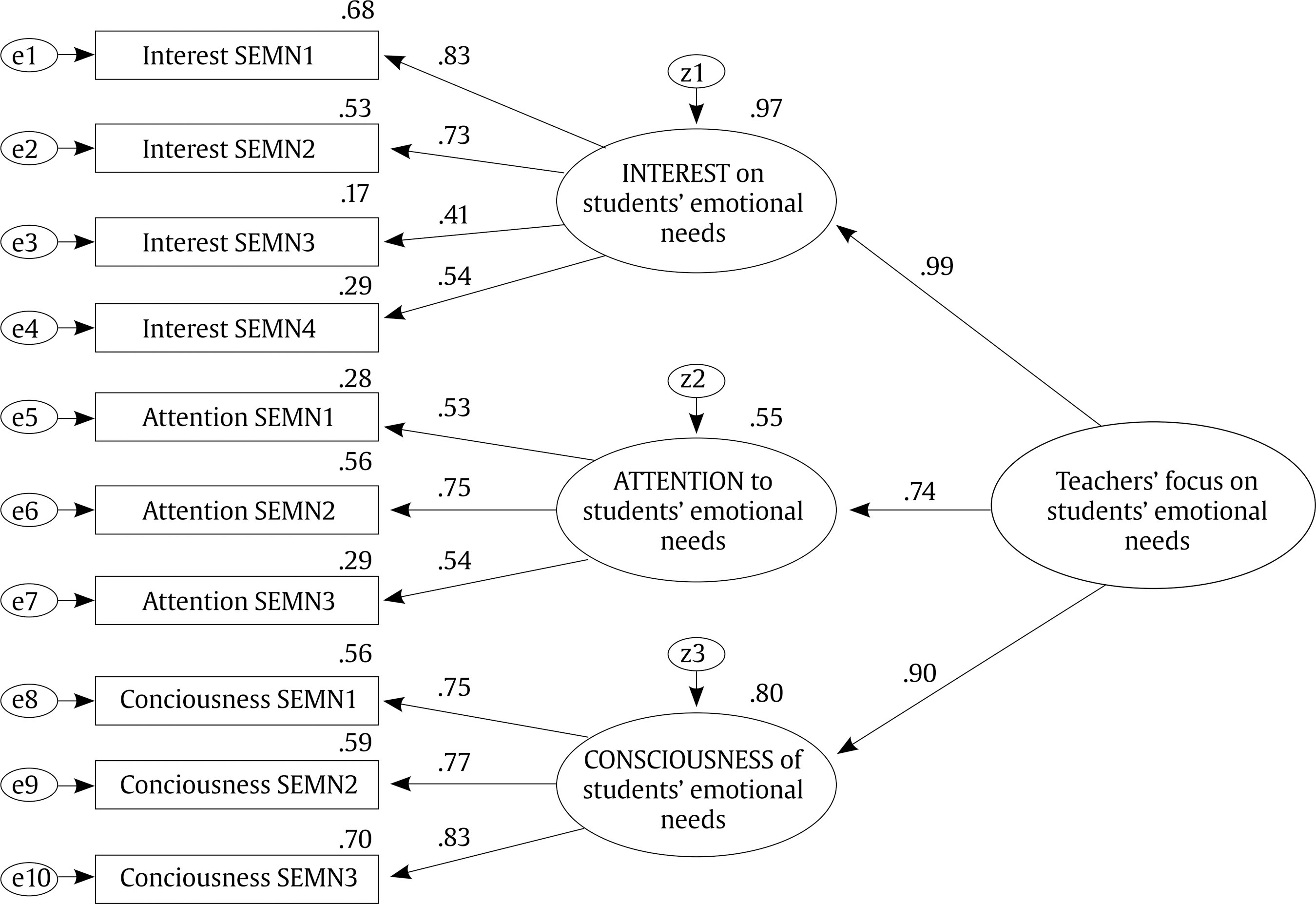 Note. SEMN = students’ emotional needs. As for the second set of analyses, its objective was to estimate the relative weight of the variables assessed by each component of school climate and by the new questionnaires in predicting the CMC. In all these analyses, the direct method was used. For this last set of analyses, the teacher sample was formed only by 265 individuals, those whose pupils had answered the CMC. Confirmatory Factor Analyses Analyses of baseline models. Figures 2 to 5 show the standardized factor loadings for the baseline CFA models. Table 1 shows the fit statistics for the baseline models (CFA1, CFA4, CFA7, and CFA10). In all cases, except CFA4, the statistic χ2 was significant, probably due to sample size (Hair et al., 2010), but the χ2/df ratio and the remaining fit indices were well inside the limits of the model acceptance. The only exception took place in the analysis of the Teachers’ Motivational Knowledge questionnaire (TMK), where the TLI and CFI indexes fell slightly short of the standard limits of significance. Figure 5 Teachers’ Expectations concerning Students. (TEXPS). Standardized Weights and Variance Explained.  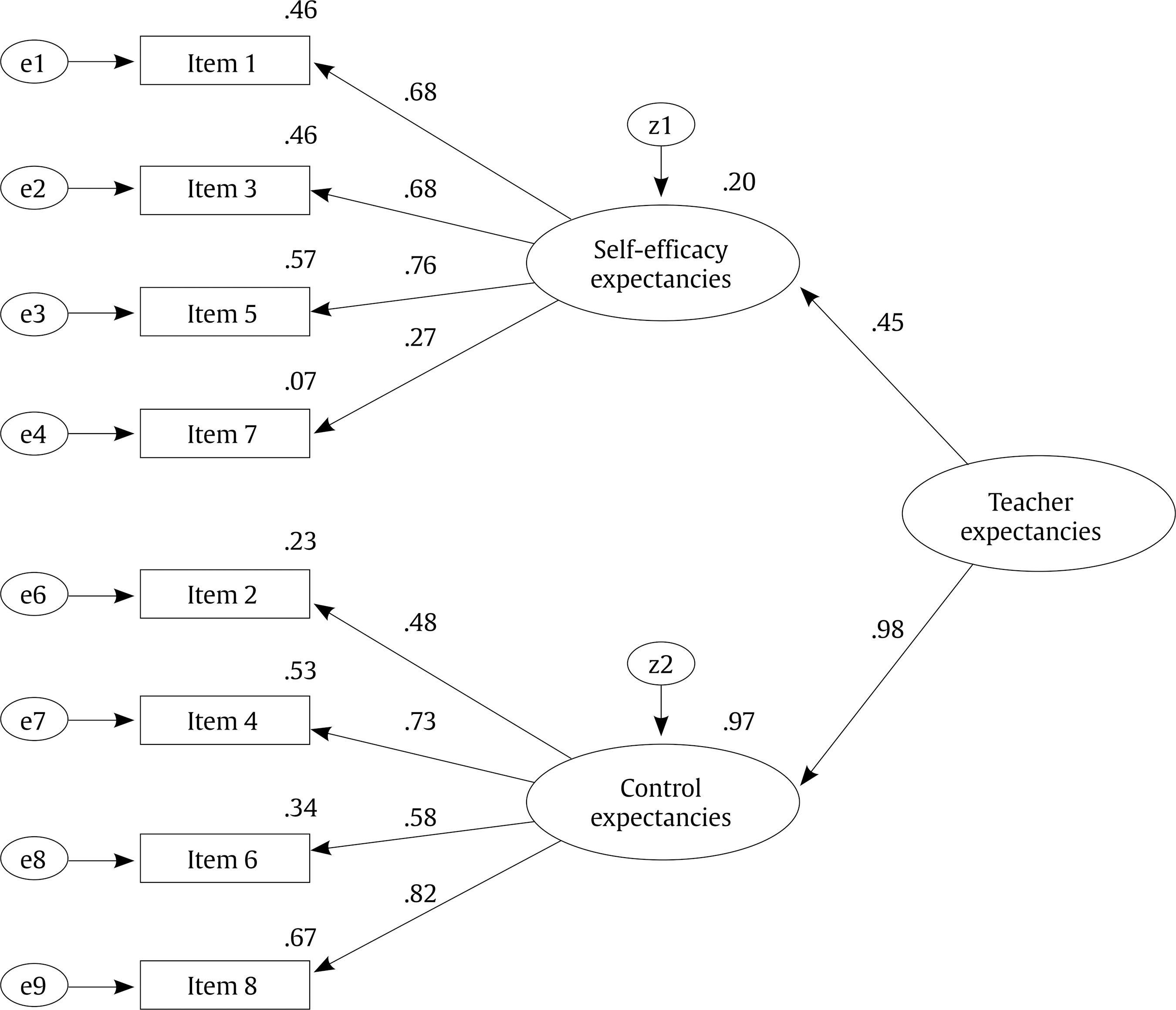 Table 1 Goodness of Fit Statistics for Each Baseline Model Tested corresponding to Each Questionnaire and for Multi-group Cross-validation Analyses  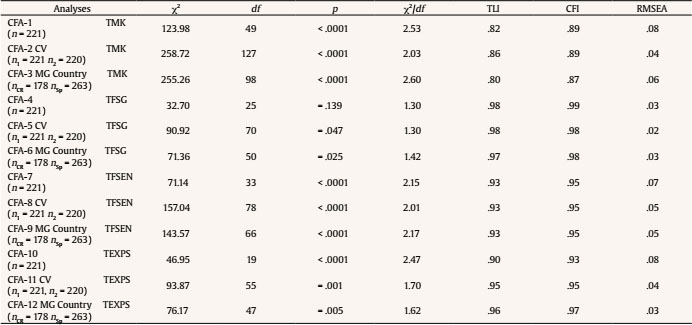 Note. TMK = teachers’ motivational knowledge; TPGOS = teachers’ performance goal orientation on students; TOSEN = teachers’ orientation to students’ emotional needs; TEXPS = teachers’ expectancies on students. Results of the cross-validation analyses are displayed also in Table 1 (CFA2, CFA5, CFA8 and CFA11). It is shown that, except for the χ2 statistic (which was significant in all analyses, probably due to sample size), the rest of the models showed satisfactory goodness-of-fit indexes, according to the recommended cutoff values (configural invariance). The only exception took place in the case of TMK, where TLI and CFI indexes fell slightly short on the standard limits of significance. However, in this case, fit did not decrease even if restrictions for parameter equality were imposed on measurement weights (Dχ2 = 9.66, p = .14), measurement intercepts (Dχ2 = 26.59, p = .09), structural weights (Dχ2 = 30.44, p = .14), structural covariances (Dχ2 = 30.50, p = .17), and structural residuals (Dχ2 = 32.49, p = .30). The same happened in the case of the TFSG questionnaire if restrictions were imposed on measurement weights (Dχ2 = 5.01, p = .54), structural weights (Dχ2 = 6.34, p = .61), structural covariances (Dχ2 = 7.57, p = .58), structural residuals (Dχ2 = 8.81, p = .72), and measurement residuals (Dχ2 = 17.07, p = .65). In a similar way, in the case of TFSEN fit did not decrease if restrictions were imposed on measurement weights (Dχ2 = 3.76, p = .81), structural weights (Dχ2 = 9.75, p = .37), structural covariances (Dχ2 = 10.91, p = .36), and structural residuals (Dχ2 = 19.50, p = .08). Finally, similar results are obtained in the case of the TEXPS if restrictions are imposed on measurement weights (Dχ2 = 6.14, p = .41), structural weights (Dχ2 = 8.69, p = .28), structural covariances (Dχ2 = 10.17, p = .25), structural residuals (Dχ2 = 13.70, p = .13), and measurement residuals (Dχ2 = 25.46, p = .09). Therefore, it can be concluded that all models are well estimated. Multi-group Analyses by Country Results of the multi-group analyses by country are also displayed in Table 1 (CFA3, CFA6, CFA9, and CFA12). It shows that the statistic χ2 was significant again in all analyses (probably due to sample size) and that, except in the case of the TMK, the rest of the models showed satisfactory goodness-of-fit indexes, according to the recommended cutoff values. In the case of TMK, the χ2/df ratio and the RMSEA fit index attained acceptable values, whereas TLI and CFI indexes fell slightly short of the standard limits of acceptance. However, fit does decrease in the case of TMK, TFSG, and TFSEN if restrictions of parameter equality are imposed, but not in the case of TEXPS. In this case, fit did not decrease even if restrictions of parameter equality were imposed for measurement weights (Dχ2 = 4.86, p = .56), structural weights (Dχ2 = 5.06, p = .65), structural covariances (Dχ2 = 5.59, p = .69), and structural residuals (Dχ2 = 8.22, p = .51). Due to the decrease of fit found in the case of TMK, TFSG, and TFSEN when restrictions of parameter equality were imposed, it was decided to calculate in these cases the statistic Z of Clogg et al. (1995) to test which differences between regression weights were significant (Z > ± 1.96). In the case of TMK, the results of this analysis showed that for SP teachers the weight of “relating subjects” (Z = -2.81) is significantly greater as an indicator of TMK than for CR. In the case of TFSG, the results showed that for CR teachers, the weights of “item 2” (Z = 2.64) and item 7 (Z = 2.13) were greater as indicators of first-order factors of TFSG than for SP teachers. Finally, in the case of TFSEN, the results showed that for SP teachers the weights of the item “interest 2” (Z = -2.55) and the item “consciousness 2” (Z = -2.89) were greater as indicators of first-order factors of TFSEN than for CR teachers. Reliability Analysis Table 2 shows in its diagonal Cronbach’s α reliability coefficient for the scales used in the study those corresponding to the new questionnaires and those corresponding to the scales used for studying the convergent validity of the new battery. McDonald ω indexes for the same variable are shown in a line at the bottom of the same table, just above the means. All reliabilities were adequate, except for Teachers’ Self-efficacy Expectancies (TSE) which fell slightly short of the threshold for acceptance. Table 2 Correlations between School Climate Perception, Teachers’ Motivational Variables, Teachers’ Satisfaction, and Classroom Motivational Climate  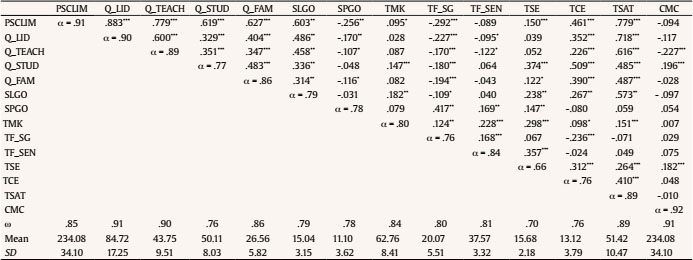 Note. N = 441 except for correlations with CMC, where N = 265; PSCLIM = perceived school climate; Q_LID = quality of leadership; Q_TEACH = quality of teachers’ mutual support;Q_STUD = quality of students’ attitudes; Q_FAM = quality of family support to teachers; SLGO = school Learning goal orientation; SPGO = school performance goal orientation; TMK = teachers’ motivational knowledge; TF_SG = teachers’ focus on students’ grades; TF_SEN = teachers focus on students’ emotional needs; TSE = teachers’ efficacy expectancies on students; TCE = teachers’ control expectancies on students; TSAT = teachers’ satisfaction with school; CMC = classroom motivational climate; SD = standard deviation. On the diagonal Cronbach α reliability indices. Mean and standard deviation of each variable. Correlation Analysis Table 2 shows the correlations between all the variables in the study. A detailed look allows identifying several features on their construct validity. First, according to Hair et al. (2017), whenever the correlation between two dimensions or variables is lower than .708, those two variables are thought to assess different constructs, since the proportion of shared variance (R2) is less than 50%. This is the case for all measures of the new questionnaires (TMK, TFSG, TF_SEN, TSE, TCE). Therefore, their discriminant validity is adequate. Second, correlations for all variables with teacher satisfaction (TSAT), a variable that will be used as the criterion in the regression analyses, show that correlations are not significant in some cases (SPGO, TFSG, TF_SEN). This lack of significance will be explained in the discussion below. Anyhow, only the variables whose correlation with teachers’ satisfaction was significant would be used in the corresponding regression analysis. Third, similarly, only three variables (Q_TEACH, Q_STUD, TSE) have a significant correlation with CMC. The implications of this result will be commented on in the Discussion section. Anyhow, only the variables mentioned will be used in the corresponding regression analysis. Regression Analyses Criterion: Teachers’ satisfaction with school (T_SATISF). Table 3 shows the results for the five analyses performed. In all cases, R was statistically significant. In the first analysis, predictors explained 19% of the variance. The only variables with a significant weight were those related to teachers’ expectancies (TSE, TCE). In the second, the introduction of teachers’ perception of school climate (PSCLIM) increased the explained variance up to 63.3%. Efficacy expectancies (TSE) were also a significant predictor, as in the previous analysis. In the third analysis, the use of components of PSCLIM, all presented significant weights and slightly increased the explained variance up to 67.6%. Finally, analyses 5 and 6 showed some differences between the two samples. Quality of teachers’ mutual support and school mastery goal orientation was more associated with SP than CR teachers’ satisfaction, whereas the opposite happens in the case of quality of family support to the school. As for personal predictors, efficacy expectancies was significant, but only in the case of SP teachers. Table 3 Regression Analyses. Criterion: Teachers’ Satisfaction with School. Predictors: 1) Teachers’ Motivational Variables Related to Students, 2) Teachers’ Perception of School Climate and Teachers’ Motivational Variables Related to Students. Standardized Coefficients   Note. T_S = total sample; CR_S = Costa Rican sample; SP_S = Spanish sample; PSCLIM = perceived school climate: Q_L = quality of leadership; Q_T = quality of teachers’ mutual support; Q_S = Quality of students’ attitudes; Q_F = quality of family support to the school; SMGO = school mastery goal orientation; TMK = t teachers motivational knowledge; TSE = teachers’ efficacy expectancies on students; TCO = teachers’ control expectancies on students. **p < .01, ***p < .001. Criterion: Classroom motivational climate (CMC). Table 4 shows the results for this set of analyses. In the first one, using the whole sample, three of four predictors – two components of school climate (Q_TEACH, Q_STUD) and teachers self-efficacy expectancies (TSE) – explained the 16.1% of the variance. In the two remaining analyses, each one using only one of the country samples, though the variance explained was significant in both cases, its value was almost double for the CR (25.6%) than for the SP sample (13.1%). Besides, important differences were found in the predictors attaining significance. In the CR sample, the main predictors were “quality of students’ attitudes” and “teacher focus on students’ grades”, both with a positive weight. In the SP sample, the main predictors, both with negative weight, were the variables “quality of teachers’ mutual support” and “teacher focus on students’ grades”. Table 4 Regression Analyses. Criterion: Classroom Motivational Climate. Predictors: 1) Teachers’ Motivational Variables Related to Students, 2) Teachers’ Perception of School Climate and Tachers’ Motivational Variables Related to Students. Standardized Coefficients   Note. T_S = total sample; CR_S = Costa Rican sample; SP_S = Spanish sample; TF_SG : teachers’ focus on students’ grades; Q_TEACH = quality of teachers’ mutual support; Q_STUD = quality of students’ attitudes; TSE = teachers’ efficacy expectancies on students. *p < .05, **p < .01, ***p < .001. The main objectives of this research were to study the potential effect of teachers’ perception of school climate and teachers’ motivational variables related to students on teachers’ satisfaction with school and classroom motivational climate, and to validate a battery of questionnaires, abbreviated from instruments developed in a previous study (Garazo, 2016), for assessing teachers’ motivational knowledge, teachers’ focus on students’ grades and emotional needs, and teachers’ expectancies. What are then the main contributions of this study? As for the scale validation analyses, the results have shown that the structure of all the questionnaires is well identified, that their scales have adequate discriminant validity and reliability, though the subscale TSE should be improved, perhaps increasing its length. As for their predictive validity (which has to do with the main objective of our study), we have been able to identify contextual and personal factors responsible for teachers’ satisfaction with school and of the quality of CMC. Considering “contextual factors” – school climate and its components –, as expected, all contribute to teachers’ satisfaction with school, being the perceived mastery orientation of the school, quality of leadership, and quality of teachers’ mutual support the most important ones. Besides, regression analyses have shown that school climate and its components are more important than personal factors in predicting teachers’ satisfaction. Only three of these – TMK, TSE, and TCE – have a significant relationship though, according to the regression analysis, only TSE adds some weight to prediction. However, the relation of school climate and its components with the degree to which CMC is learning-oriented does not completely correspond to our expectancies. First, only “quality of teachers’ mutual support” and “quality of students’ attitudes” have a significant relationship with CMC in the whole sample, but it is negative in the case of quality of teachers’ mutual support. Besides, when considering separately the CR and SP subsamples, the main contextual predictors are the same, but “quality of teachers’ mutual support” fell short of the standard levels of significance in the CR subsample, whereas it is “quality of students’ attitudes” which fell short of significance (p = .08) in the Spanish subsample. Since we are working with correlations, the positive relationship of quality of students’ attitudes with CMC can be easily explained: the better the students’ attitudes, the better the teacher disposition to improve their teaching and vice-versa. However, there are two facts not so easy to explain. First, the negative relationship between “quality of teachers’ mutual support” and CMC. It may be the case that receiving stimulus and help is interpreted as a sign of low personal value, a perception linked to low self-efficacy, given that the influence of perceived self-efficacy is already accounted for by teachers’ self-efficacy expectancies in the model. Second, the lack of significant and positive relationship between two components of perceived school climate on one side – the quality of leadership and school mastery goal orientation – and CMC on the other side. CMC might be more linked to personal factors than to school factors. If this explanation was true, then interventions aimed at improving the CMC should be addressed directly at modifying teachers’ factors (Lazowski & Hulleman, 2016), without considering the school climate components. As for “personal factors” and their relationships with teacher satisfaction, only TMK, TSE, and TCE contribute significantly, an expected relationship considering the facts revealed by the review of the research on TSE by Zee & Koomen (2016), and the positive correlation between the three mentioned variables. However, when school climate or its components are introduced in the analysis, the effect of TCE is non-significant. Similarly, TSE relates in a positive and significant way with CMC. This is also an expected relationship, considering the facts revealed by the review of the research on TSE by Zee & Koomen just quoted. Nevertheless, there is also an unexpected result related to the relationship between personal factors and CMC. This is the lack of significant correlations between, on one side, teacher satisfaction (TSAT), motivational knowledge (TMK), focus on students’ grades (TFSG), and focus on students’ needs (TFSN), and, on the other side, CMC. In the case of “teacher satisfaction”, it may be that satisfaction with school and satisfaction with personal achievement and fulfillment of basic needs (relatedness, competence, and self-determination) (Deci & Ryan, 2000) are not related and that this last satisfaction is the one that influences the creation of a CMC learning-oriented. For example, Mascret et al. (2017) pointed out the fact that teachers’ personal achievement goals can be centered on enabling their students to succeed or on avoiding them to failure, on improving personal competency or on avoiding personal failure, or on being better than other teachers or on avoiding being worse than them. Depending, thus, on their personal goals and on the degree to which they are satisfied, their effort and efficiency in motivating their students would differ. In the case of “teachers’ motivational knowledge”, a plausible explanation can be that knowing how to motivate does not imply the will to apply such knowledge, due to the “cost” or effort necessary for its application. For example, giving qualitative, adequate, frequent, and individualized feedback is a very important component of CMC. However, even if teachers know this fact, giving such feedback is more difficult than only giving a mark expressing whether an exercise is correct or not. Similarly, “to focus on effort, not only on marks, for giving grades”, implies detailed attention to the learning process of each pupil, which is more costly than relying only on a test or exam. Finally, “to focus on students’ emotional needs” demands not only the will to do it, but also to expand the area of teachers’ responsibilities, which also implies a greater cost. Given all these possibilities, the “cost” hypothesis should be tested, as it would have practical implications. According to the above considerations, our results have some theoretical and practical implications. First, they help us to build a model of factors potentially affecting teacher satisfaction. Such a model should include the perceived mastery orientation of the school, the quality of leadership, and the quality of teachers’ mutual support, as these contextual factors have the greatest effect and teacher self-efficacy expectancies. Related to this theoretical implication there is a practical one. To increase teachers’ satisfaction, school managers should try to act according to the managing patterns assessed through the Leadership Quality Questionnaire described in the Instruments section. Second, the suggestion that the unexpected results between “quality of teachers’ mutual support” and CMC might be caused by the interpretation of receiving stimulus and help as a sign of low personal value, a perception linked to low self-efficacy, need to be tested. If this hypothesis were correct, then teacher self-efficacy should be increased to improve CMC – if possible – by improving previously their motivational knowledge. Though this variable has not a direct relationship with CMC, it might have an indirect one, a hypothesis that should also be tested. Third, it has been suggested that the lack of relationship between, on one side, teachers’ motivational knowledge, focusing on students’ effort, and on students’ needs, and, on the other side, CMC, could be attributed to a lack of motivation due to the “cost” of applying knowledge and focusing on students’ effort and emotional needs. If this hypothesis were correct, the problem would not be teaching teachers how to create a CMC learning-oriented, making them conscious of the importance of considering student’s effort and progress and not only on performance when giving grades, or on the importance and role of dealing with students socio-emotional needs, but rather motivating teachers to act accordingly to such knowledge. Our study has some limitations related to its scope. There are variables not considered. First, teachers’ personal achievement goals, already commented, may play an important role in creating a CMC learning-oriented (Mascret et al., 2017). Second, Butler (2012) and Alonso-Tapia, Ruiz, et al. (2020) suggested that teachers’ social orientation – the degree to which they are interested in each student as a person – seems to motivate them to improve the CMC. However, this seems not to be the same as focusing attention on students’ socio-emotional needs. Third, the CMCQ allows assessing not the CMC created by the teacher, but the CMC perceived by students, and their perceptions may be moderated by personal variables such as goals or expectancies. Due to this fact, it seems reasonable to include such variables in a multilevel analysis of factors affecting the CMC, an analysis that remains to be done. Besides, school climate teacher motivational variables can be related in complex ways that, if known, would have allowed analyzing our data with SEM techniques. All these are some of the limitations of this study that should be dealt with in future studies on the determinants of CMC. Conflict of Interest The authors of this article declare no conflict of interest. Cite this article as: Alonso-Tapia, J., & Ruiz-Díaz, M. (2022). School climate and teachers’ motivational variables: Effects on teacher satisfaction and classroom motivational climate perceived by middle school students. A cross-cultural study. Psicología Educativa, 28(2), 151-163. https://doi.org/10.5093/psed2022a4 References Appendix A 1. Teachers’ Applied Motivational Knowledge Next, you will find a series of comments through which we transmit to the students what we consider important, comments that refer to objectives and work modes you emphasize. Your task is to indicate the approximate frequency with which you make these comments. To answer, choose the option that represents your degree of agreement with the content of the affirmation, according to the following scale:   Note. NOV = novelty; PKN = previous knowledge activation; TSR = teacher relates subjects; OBJ = clarity of objectives and task organization; FBK = use of feedback; PRAISE = use of praise. Questionnaires 2, 3, & 4 Respondents have to show their degree of agreement with item content on a scale from 1 (total disagreement) to 5 (total agreement) |
Para citar este art├Łculo: Alonso-Tapia, J. y Ruiz-Díaz, M. (2022). School Climate & TeachersŌĆÖ Motivational Variables: Effects on Teacher Satisfaction and Classroom Motivational Climate Perceived by Middle School Students. A Cross-cultural Study. Psicolog├Ła Educativa, 28(2), 151 - 163. https://doi.org/10.5093/psed2022a4
jesus.alonso@uam.es Correspondencia: jesus.alonso@uam.es (J. Alonso Tapia).Copyright © 2026. Colegio Oficial de la Psicología de Madrid


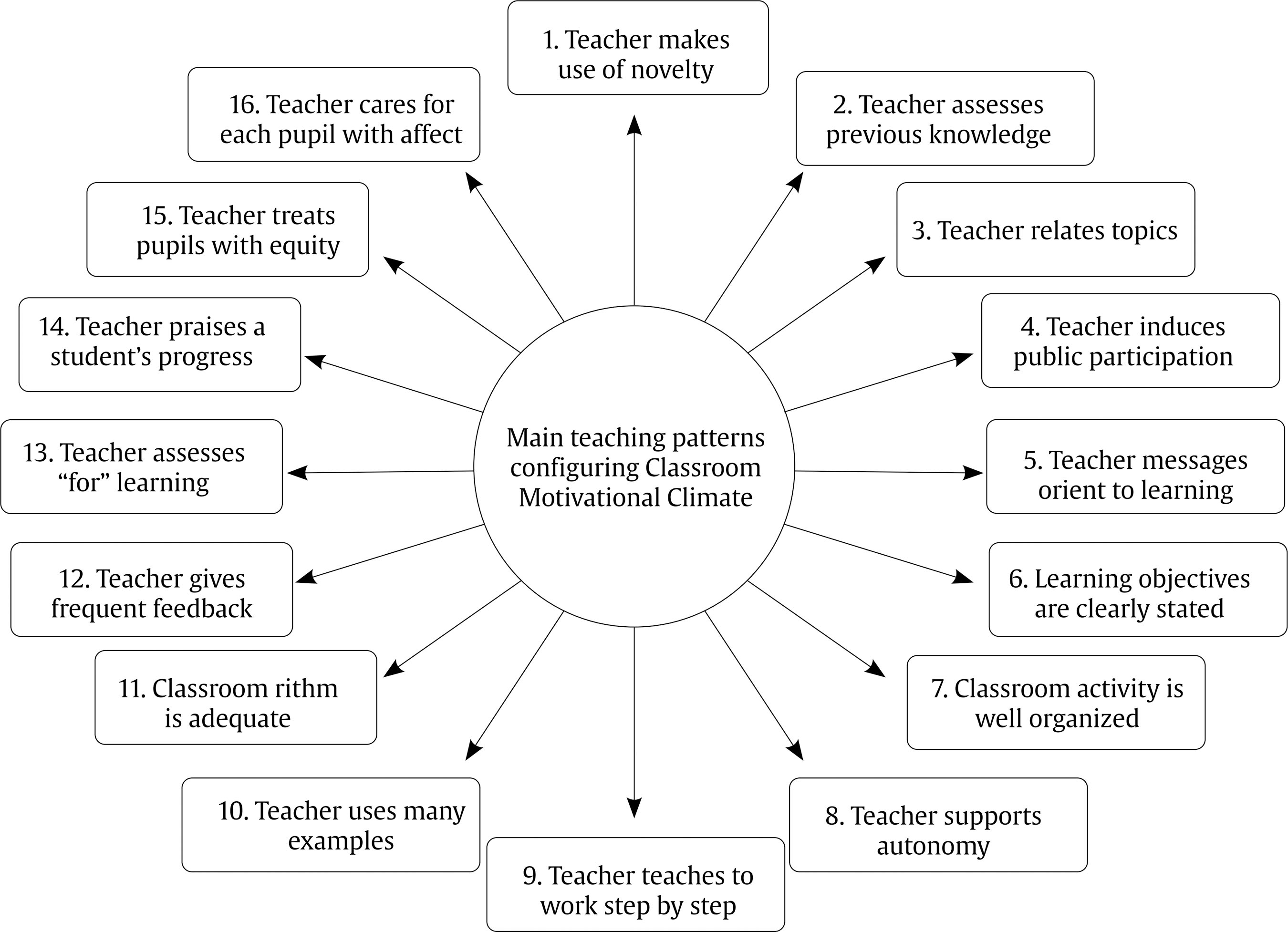
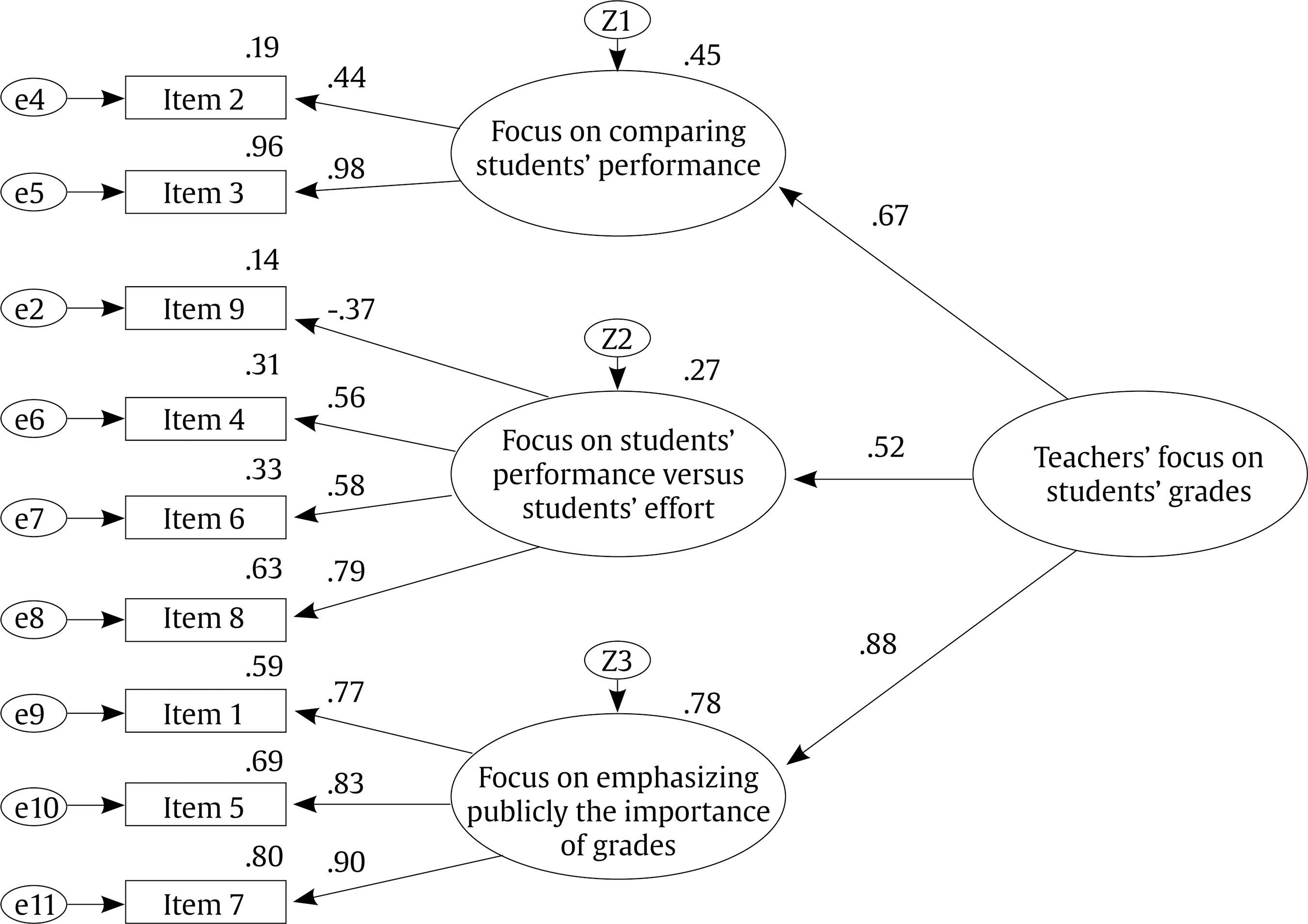
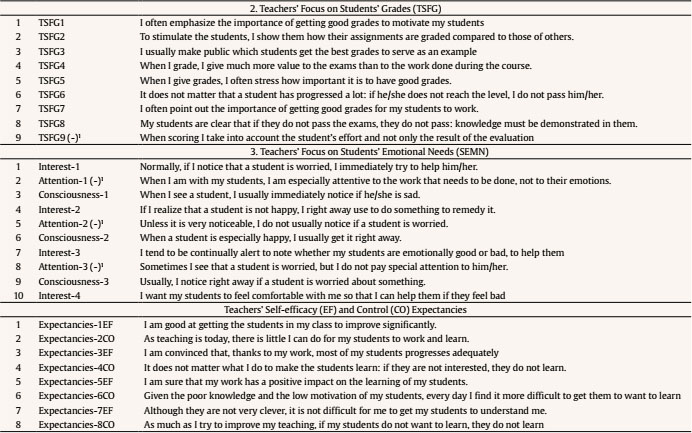






 e-PUB
e-PUB CrossRef
CrossRef JATS
JATS








